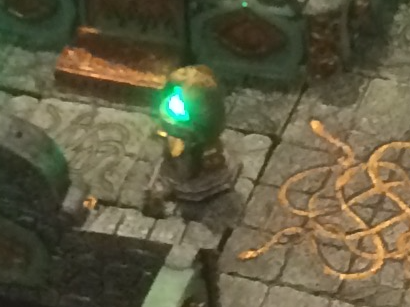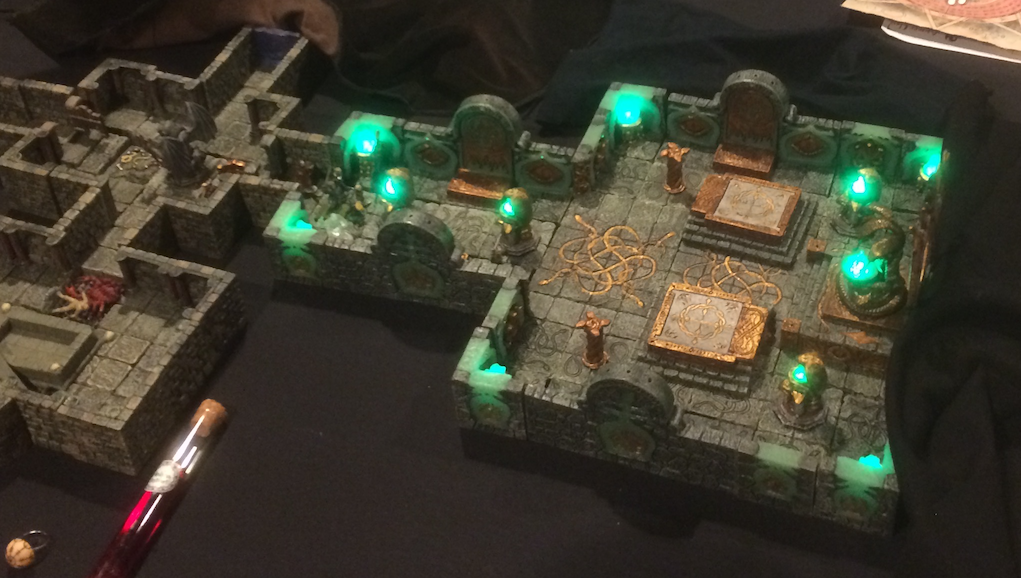Earlier this week, Dungeons & Dragons fans got a real treat when professed D&D and Tolkien geek Stephen Colbert sat down to play D&D with DM Matthew Mercer from Critical Role.
Colbert started his entertainment career in improv, and it seems like a good fit with today’s theatrical style of games with extended conversations, funny voices, and deep character development. He could go full Stephen and narrate all of his actions in detail and get deeply invested in his character’s motivations.
However, he doesn’t. He’s actually surprised by the “props” and gets down to business by concisely (but specifically) describing his actions. He lets his DM do all of the explaining. It’s different, but it’s consistent with how Colbert likely played the Advanced Dungeons & Dragons (AD&D) rules from the 70s.
This reddit thread explains this different, “OSR” gaming style, and unless you have played it, old school D&D probably sounds crazy and brutal. You just die when you have 0 hit points? You walk around with a 10-foot pole to avoid traps? You can’t roll to persuade someone?
Excluding a few one-off experiences, I hadn’t played this style before, and it generally didn’t seem like much fun. OSR games sounded laborious and unfair. However, I coincidentally also played a AD&D game called “The Gauntlet of Doom” at KublaCon this past weeknend run by Stefan from Dwarven Forge. I signed up just for the badge of experiencing it, but 8 hours later, I see how this completely different style of game can be a blast.
Let me run through a few things that happened in that game.
Dead at 0 Hit Points
Our adventure started in a tavern, and we had a short but amusing and innocuous journey to the dungeon. When we got to the first real battle, all of us 1st level fighters charged into combat to take on the Ogres and Kobolds
One player just managed to run up to the fight when the Ogre hit him first for 15 points of damage. Having yet to make a meaningful choice in the game, his character instantly died. The player laughed, picked up his stuff, and left the room.
In AD&D, when you go down to 0 hit points, you are dead. That’s it. There are no second chances or opportunities for someone to heal you. You are done.
In my modern Dungeons & Dragons 5th Edition (5E) games, I have had maybe two or three characters die ever, and each death was tragic. These players had worked hard on backstories and become emotionally invested in their characters experiencing the entire story.
In contrast, by the end of this battle, two other players were dead. Immediately after that, our Magic-user (i.e. Wizard) tried to climb over the side of the wall and failed his climbing check. He fell, took 5 points of damage, and died.
And in each case, everyone laughed. We all knew what to expect, and because it was so arbitrary, we couldn’t do anything other than laugh at their misfortune and count our blessings to have lived. The players knew that a roll of the dice separated our survival from another’s death. In the face of the inevitable, all of you can do is enjoy the journey and how it all ended.
Tediously Checking for Traps
All AD&D players knew to always carry a 10-foot pole to trigger pressure plates before stepping anywhere in a dungeon. Of course, we didn’t do anything like that. We used a Halberd and carried the corpse of a giant scorpion to trigger pressure plates.
This strategy came after I triggered the first big trap that I saw coming but couldn’t avoid. We were fighting the giant scorpion, it started to push me. The DM specifically asked me where I was moving out of its way.
It was just gambling, and I guessed wrong. I got pushed into a pit of snakes. They didn’t seem so scary at first, but to rescue me, a Thief jumped over the scorpion, got clipped by a pincer, fell into the pit, took falling damage, got bit by a snake, failed a poison saving throw, and instantly died.
And then the snakes had about another 15 attacks on me before the other players had a chance to lower the severed tail of the scorpion into the pit to lift me out.
Was the pit unfair? Absolutely. I guessed wrong on a 50-50 where I couldn’t have gathered any more information than I did. Was I angry? Absolutely not. I was on the edge of my seat every time the DM rolled to see if I lived.
Traps really aren’t very popular in modern. When the players are surprised a spike pit, they will make Perception checks every 5 feet to avoid more traps. Common DM advice is to tip the players off to a trap (e.g. “When you walk into the room, you see skeletons with darts sticking out of them”) so that they can intentionally make Perception checks and avoid wasting time.
But in this game, checking for traps wasn’t wasting time: it was the point of the game. When you know that you are supposed to die in some very unfair manner, it is really exciting to actually survive. It’s pure gambling with super-long odds.
And when you actually do something clever to stay alive, you feel brilliant.
There are no Insight checks
“No, you can’t dodge. You’re always dodging.”
“This is AD&D. There is no perception roll.”
“You don’t roll to pick the lock. The DM rolls for you.”
In our final encounter, we were in a standoff against lizardfolk amidst a ritual. Another player (let’s call him “Phil”) told the rest of the players that we needed to help the lizardfolk complete the ritual. If we helped them, the lizardfolk would leave. Then, we could destroy the altar and loot the room. It sounded exactly that fishy, and we argued at length about what we should do.
Were we playing 5E, I would have asked the DM to roll an Insight check. If I rolled high enough, the DM would whisper something to me, and then I would announce my well-informed choice to the party who could follow my insightful lead.
Because we were playing AD&D, all I could was look Phil and the DM in the eyes and guess whether they were trying to screw us over. It wasn’t about whether my character had the talent to get through this encounter: it was about whether I as the player was clever enough to figure out what to do.
At the last second when we were about to lie down on the altar, we launched a surprise attack. When one of Phil’s allies shot our Cleric in the back and killed him, we realized that we were indeed being screwed.
Despite living and dying by the dice the entire game, when it mattered the most, we couldn’t rely on the dice to solve our biggest problem. It was just player against player against DM, and playing in and releasing that tension was more fun than any dice resolution I have experienced.
How It All Ended
This game was a complete screw job from top to bottom. Overpowered monsters, random traps, and planned player betrayal make it very difficult to survive much less triumph.
After the betrayal, the 4 good players left ran for the door, and Phil unleashed a Fireball between us that was plenty powerful to kill us all. I knew we were dead.
And then we looked at the game board and saw that there was one snake statue between us and Phil.

After getting mercilessly punished by the DM for seven and a half hours, I thought he would rule that he could step to the side and cast the fireball. Or maybe he could angle it differently. However, the DM let the action stand. The Fireball hit the side of the statue, blew up amongst the evil characters and Lizardmen, and killed almost all of them. And we ran away from the rest of them.
So, when out of 16 players who cycled through the game, 4 of us ran away to fight another day, we loved it. Our only prize for 8 hours of play was that we didn’t die, but we truly felt like we earned that victory because it was just so unfair.
Final Thoughts
This post largely contrasted classic and modern styles of D&D. I also focused on the highlights of this one game without mentioning how much I love my current games. But really, games exist on a spectrum.
Playing “The Gauntlet of Doom” reminded me that I love tabletop RPGs because you can mold the experience into an infinite number of options by your imagination, and that fun comes in just as many flavors. Just because we learned from previous games and rulebooks doesn’t mean the old stuff isn’t fun: you just have to have the right mindset for it. We’re all just looking for an epic win for whatever that means to each of us.
